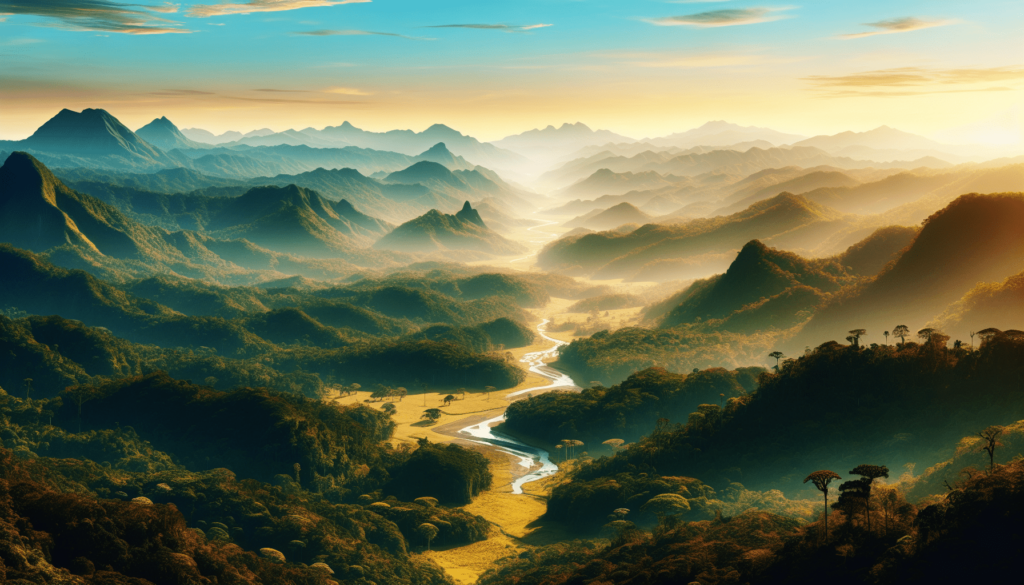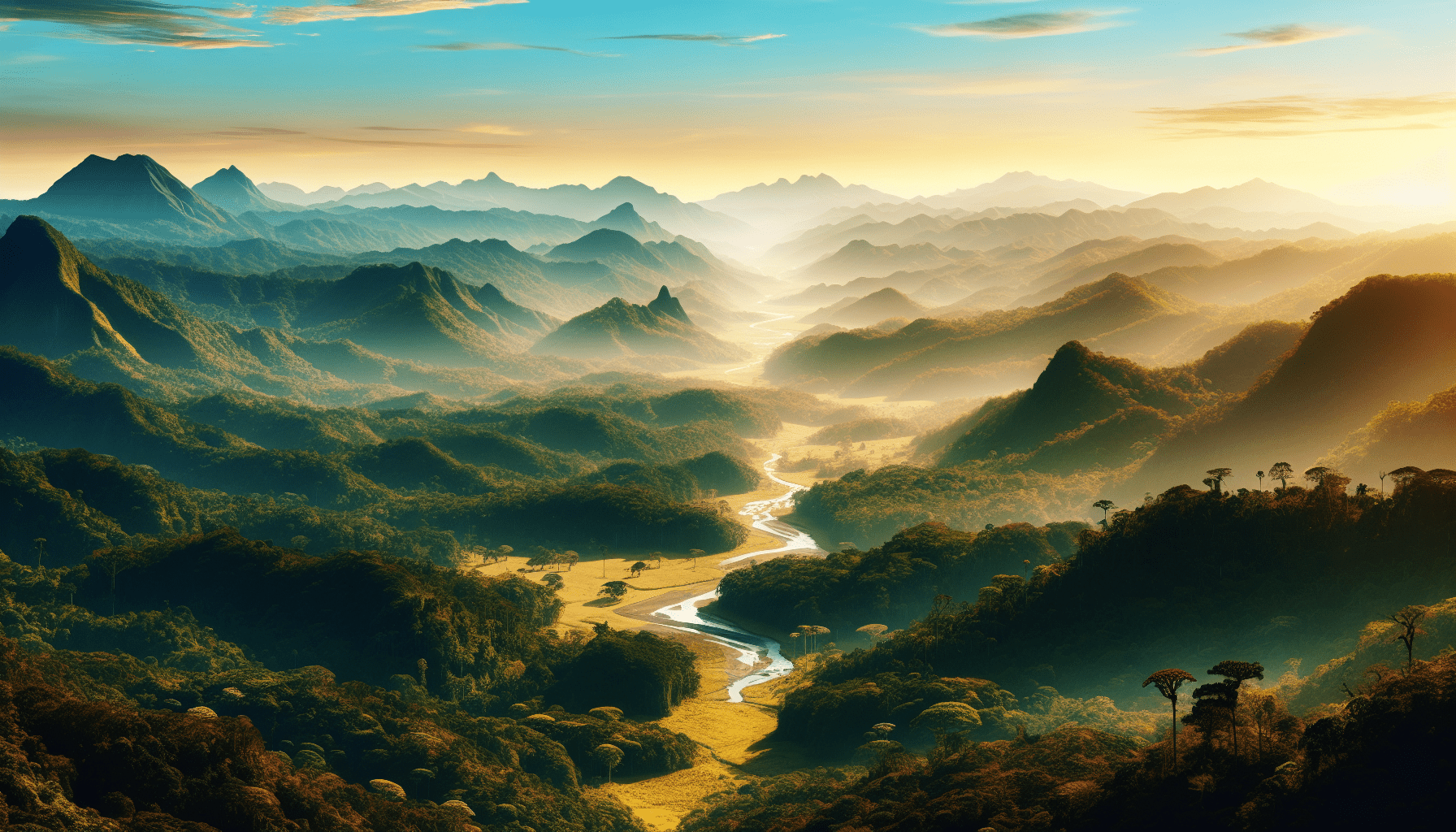If you find yourself in Guanacaste, Costa Rica, you’re in for a treat. This beautiful region is home to an array of stunning national parks that are just waiting to be explored. From lush rainforests to volcanic landscapes, there is something for every nature enthusiast. In this ultimate day trip guide, we will take you on a journey through Guanacaste’s national parks, providing you with all the information you need to plan your perfect adventure. Whether you’re a hiker, a wildlife lover, or simply looking to immerse yourself in the breathtaking scenery, get ready to discover the hidden treasures of Guanacaste’s national parks.

Understanding Guanacaste’s Terrain
Guanacaste, located in Northwestern Costa Rica, is a region known for its diverse terrain that offers a plethora of outdoor experiences for nature enthusiasts. From towering volcanoes to pristine beaches, Guanacaste’s landscape has something to offer for everyone. Understanding the terrain of this region will not only enhance your appreciation of its natural beauty but also help you plan your visit effectively.
Geographical Overview of Guanacaste
Guanacaste is nestled between the Pacific Ocean to the west and the Tilarán Mountain Range to the east. This unique geographical positioning creates a wide range of ecosystems within the region. From expansive coastal plains to dense rainforests and volcanic peaks, Guanacaste’s terrain holds great biodiversity. As you explore the diverse national parks in the area, you’ll experience the wonders of tropical dry forests, lush wetlands, and stunning geological formations.
Discovering Costa Rica’s Varied Biodiversity
Costa Rica is renowned for its incredible biodiversity, and Guanacaste is no exception. The region is home to an astonishing array of flora and fauna, thanks to its varied terrain. While exploring Guanacaste’s national parks, you can expect to encounter a wide range of wildlife, such as howler monkeys, tapirs, hummingbirds, and even jaguars. The region’s rich biodiversity creates exciting opportunities for birdwatching, wildlife photography, and eco-tourism. So, don’t forget to bring your binoculars and camera to capture the unforgettable moments.
Rincon de la Vieja National Park
Rincon de la Vieja National Park is a must-visit destination for nature lovers and adventure seekers. This park, situated along the Cordillera de Guanacaste mountain range, offers a unique experience with its active volcanic landscape and rejuvenating hot springs.
Park Locations and Visiting Hours
Rincon de la Vieja National Park is located approximately 25 kilometers northeast of Liberia, the capital city of Guanacaste. The park is easily accessible by road, and there are parking facilities available for visitors. The park is open daily from 8:00 AM to 4:00 PM.
Main Attractions: Volcanoes and Hot Springs
One of the main highlights of Rincon de la Vieja National Park is the active volcano, which shares its name with the park. You can witness smoke vents, fumaroles, and boiling mud pots, showcasing the park’s volcanic activity. Additionally, the park boasts several hot springs, where visitors can relax and rejuvenate amidst breathtaking natural surroundings.
Hiking Trails: Equipment and Best Time to Visit
To fully explore the wonders of Rincon de la Vieja National Park, hiking is highly recommended. The park offers a variety of hiking trails, ranging from easy to challenging, suitable for all fitness levels. It is advisable to wear sturdy hiking shoes, carry a backpack with essentials like water, sunscreen, and insect repellent, and dress in comfortable and breathable clothing.
The best time to visit Rincon de la Vieja National Park is during the dry season, which runs from December to April. The trails are generally less muddy, and the weather is more favorable for outdoor activities.
Wildlife You Might Encounter
As you traverse the trails of Rincon de la Vieja National Park, keep an eye out for the diverse wildlife that inhabits the area. You may come across playful monkeys swinging from tree to tree, colorful birds soaring through the sky, and even elusive big cats hiding in the dense foliage. Remember to observe wildlife from a safe distance and avoid feeding or approaching them to ensure their natural behavior remains undisturbed.
Available Facilities and Accommodations
Rincon de la Vieja National Park offers basic amenities for visitors, including restroom facilities and picnic areas. However, there are no restaurants or food vendors within the park, so it is advisable to bring your own snacks or a packed lunch. If you wish to extend your stay, there are accommodations available in nearby towns, offering a range of options from budget-friendly lodges to luxurious resorts.

Santa Rosa National Park
Located along the Pacific coastline of Guanacaste, Santa Rosa National Park boasts a unique blend of history and natural beauty. This park not only offers stunning beaches but also holds great historical significance as the site of the Battle of Santa Rosa.
Park Locations and Visiting Hours
Santa Rosa National Park is situated approximately 36 kilometers northwest of Liberia. The park has multiple entrances, with the main entrance located near the town of La Cruz. It is open daily from 8:00 AM to 4:00 PM.
Main Attractions: Historic Landmarks and Beaches
One of the main attractions of Santa Rosa National Park is the historical Hacienda Santa Rosa, which played a pivotal role in the Battle of Santa Rosa during the country’s fight for independence. Exploring this historic landmark offers a glimpse into Costa Rica’s rich history.
In addition to its historical significance, Santa Rosa National Park is also home to stunning beaches. Playa Naranjo and Playa Nancite are particularly popular among beach enthusiasts, offering pristine white sand and crystal-clear waters. These beaches provide a perfect setting to relax, swim, or engage in water sports such as snorkeling and surfing.
Hiking Trails: Equipment and Best Time to Visit
Santa Rosa National Park features several hiking trails that traverse its diverse landscapes, offering visitors an opportunity to immerse themselves in nature. It is advisable to carry sturdy hiking shoes, sufficient water, sun protection, and insect repellent. Wearing comfortable clothing suitable for outdoor activities is also recommended.
To make the most of your visit, plan to explore Santa Rosa National Park during the dry season when the weather is more favorable for outdoor activities. The dry season typically extends from December to April.
Wildlife You Might Encounter
As you wander through Santa Rosa National Park’s trails, be prepared to encounter a wide variety of wildlife. From playful coatis and curious raccoons to vibrant bird species and reptiles, the park is a haven for nature enthusiasts. Keep your eyes peeled and your camera ready to capture these magical moments.
Available Facilities and Accommodations
Santa Rosa National Park provides basic facilities such as restrooms and picnic areas for visitors. However, there are no food services available within the park, so it is advisable to bring your own snacks or a packed lunch. If you wish to stay overnight, there are nearby accommodations ranging from rustic cabins to beachfront hotels that offer a comfortable and convenient stay.
Guanacaste National Park
Guanacaste National Park, located in the northern part of the province, offers a unique opportunity to explore the region’s natural wonders. This park is known for its stunning views, smoke vents, and remarkable geological formations.
Park Locations and Visiting Hours
Guanacaste National Park is situated approximately 35 kilometers northeast of Liberia. The park is accessible by road, and there are parking facilities available for visitors. It is open daily from 8:00 AM to 4:00 PM.
Main Attractions: Smoke Vents and Spectacular Views
One of the main attractions of Guanacaste National Park is its smoke vents, known as fumaroles, which are a result of volcanic activity. These vents emit steam and various gases, creating an otherworldly atmosphere that is truly captivating. Exploring these smoke vents allows visitors to witness the raw power of the Earth’s geological processes.
Apart from the smoke vents, Guanacaste National Park offers breathtaking views of the surrounding landscapes. The park’s elevated vantage points provide panoramic vistas of the beautiful Guanacaste province, making it a popular spot for photography and sightseeing.
Hiking Trails: Equipment and Best Time to Visit
To fully experience the wonders of Guanacaste National Park, hiking is highly recommended. The park offers a variety of trails that cater to different fitness levels and interests. It is advisable to wear comfortable hiking shoes, carry a backpack with essentials like water, snacks, sunscreen, and insect repellent, and dress in lightweight and breathable clothing.
The best time to visit Guanacaste National Park is during the dry season, which spans from December to April. During this time, the trails are generally less muddy, and the weather is more conducive to outdoor activities.
Wildlife You Might Encounter
Guanacaste National Park is home to a diverse range of wildlife. From elusive big cats like pumas and ocelots to colorful birds such as toucans and macaws, the park provides ample opportunities for wildlife encounters. Make sure to maintain a respectful distance and avoid disturbing the animals to preserve their natural habitat.
Available Facilities and Accommodations
Guanacaste National Park offers basic facilities such as restrooms and picnic areas for visitors. However, there are no food services available within the park, so it is advisable to bring your own snacks or a packed lunch. If you plan to extend your stay, there are accommodations available in nearby towns, ranging from budget-friendly options to upscale resorts, ensuring a comfortable and enjoyable stay.

Palo Verde National Park
Palo Verde National Park, located in the Tempisque Conservation Area, is a paradise for birdwatchers and nature enthusiasts. This wetland reserve is famous for its rich avian population and scenic boat tours along the Tempisque River.
Park Locations and Visiting Hours
Palo Verde National Park is situated approximately 30 kilometers south of Liberia. The park is easily accessible by road, and there are parking facilities available for visitors. It is open daily from 8:00 AM to 4:00 PM.
Main Attractions: Birdwatching and Boat Tours
One of the main attractions of Palo Verde National Park is its incredible birdwatching opportunities. The park provides a habitat for more than 300 bird species, including the vibrant scarlet macaws, the iconic Jabiru stork, and the elusive boat-billed heron. Exploring the park’s trails and embarking on a boat tour along the Tempisque River allow you to witness these magnificent birds in their natural habitat.
In addition to birdwatching, Palo Verde National Park offers scenic boat tours that provide visitors with a unique perspective of the park’s wetlands. Cruising along the Tempisque River allows you to observe the diverse array of wildlife, including crocodiles, monkeys, and iguanas.
Hiking Trails: Equipment and Best Time to Visit
While hiking opportunities within Palo Verde National Park are limited, there are still short trails available for exploration. It is advisable to wear comfortable walking shoes, carry water, and dress in lightweight and breathable clothing. Due to the park’s wetland environment, insect repellent is also recommended.
The best time to visit Palo Verde National Park is during the dry season, which typically extends from December to April. During this period, the water levels are lower, making it easier to navigate the park’s trails and enjoy the boat tours.
Wildlife You Might Encounter
Palo Verde National Park is teeming with wildlife, making it a haven for nature enthusiasts. Apart from the diverse bird species, you can expect to encounter reptiles such as iguanas and turtles, mammals like monkeys and coatis, and even the iconic American crocodile. As always, remember to maintain a safe distance and respect the animals’ natural habitat.
Available Facilities and Accommodations
Palo Verde National Park provides basic facilities such as restrooms and picnic areas for visitors. However, there are no food services available within the park, so it is advisable to bring your own snacks or a packed lunch. If you plan to extend your stay, there are accommodations available in nearby towns, ranging from rustic lodges to comfortable hotels.
Tenorio Volcano National Park
Tenorio Volcano National Park is an untouched gem nestled in the northern reaches of Guanacaste. This park offers a unique blend of natural wonders, including the mesmerizing Rio Celeste and the towering Tenorio Volcano.
Park Locations and Visiting Hours
Tenorio Volcano National Park is located approximately 55 kilometers northeast of Liberia. The park is accessible by road, and there are parking facilities available for visitors. It is open daily from 8:00 AM to 4:00 PM.
Main Attractions: Blue Lagoon and Tenorio Volcano
The highlight of Tenorio Volcano National Park is undoubtedly the stunning Rio Celeste, or Blue River. This celestial blue river owes its vibrant color to a unique chemical reaction that occurs when two streams merge. Witnessing the striking blue waters flowing through the lush green surroundings is a sight to behold.
Another prominent feature of the park is the Tenorio Volcano. Although it is not as active as Rincon de la Vieja, the volcano provides a beautiful backdrop for your adventures within the park. The hiking trails offer you the opportunity to appreciate the awe-inspiring geological formations and lush primary rainforests, making it a paradise for nature photographers.
Hiking Trails: Equipment and Best Time to Visit
To fully immerse yourself in the beauty of Tenorio Volcano National Park, exploring its hiking trails is highly recommended. It is essential to wear sturdy hiking shoes, carry a backpack with essentials like water, snacks, sunscreen, and insect repellent, and dress in comfortable and breathable clothing.
The best time to visit Tenorio Volcano National Park is during the dry season, which runs from December to April. The trails can be challenging to navigate during the rainy season due to increased mud and slippery conditions. Be prepared for a moderate level of physical exertion on the trails as you traverse the undulating terrain.
Wildlife You Might Encounter
Tenorio Volcano National Park is home to a diverse range of wildlife, thanks to its pristine rainforest environment. As you explore the trails, keep your eyes peeled for curious monkeys, tropical birds, and even elusive felines like jaguars and ocelots. Remember to observe wildlife from a respectful distance and refrain from feeding or approaching the animals to ensure their wellbeing.
Available Facilities and Accommodations
Tenorio Volcano National Park provides basic facilities such as restrooms and picnic areas for visitors. However, there are no food services available within the park, so it is advisable to bring your own snacks or a packed lunch. If you plan to stay overnight, there are accommodations available in nearby towns, ranging from eco-lodges to comfortable hotels, providing a cozy and convenient base for your adventures.

Barra Honda National Park
Barra Honda National Park, located along the Nicoya Peninsula, is a hidden gem for adventurers seeking unique geological wonders. This park is famous for its limestone caverns and a network of forest trails that offer a glimpse into a captivating underground world.
Park Locations and Visiting Hours
Barra Honda National Park is situated approximately 50 kilometers southeast of Liberia. The park can be reached by car, and there are parking facilities available for visitors. It is open daily from 8:00 AM to 4:00 PM.
Main Attractions: Limestone Caverns and Forest Trails
The main highlight of Barra Honda National Park is its extensive network of limestone caverns, which are a natural wonder waiting to be explored. Guided tours are available for visitors to delve into the depths of these underground formations. Equipped with helmets and flashlights, you can navigate through the labyrinth of chambers while marveling at the intricate stalactites and stalagmites.
In addition to the limestone caverns, Barra Honda National Park offers a network of forest trails for hiking enthusiasts. These trails wind through the park’s pristine tropical dry forest, allowing you to immerse yourself in the captivating natural surroundings and spot various wildlife species along the way.
Hiking Trails: Equipment and Best Time to Visit
Exploring the forest trails of Barra Honda National Park requires appropriate hiking equipment. It is essential to wear sturdy hiking shoes, carry water, sunscreen, insect repellent, and a hat. The trails can be challenging, so it is advisable to be prepared for uneven terrain and steep sections. Additionally, a hiking pole may be useful to maintain balance and stability.
The best time to visit Barra Honda National Park is during the dry season when the trails are less muddy and slippery. The dry season typically extends from December to April. However, it is important to note that certain sections of the park may be closed during heavy rainfall for safety reasons.
Wildlife You Might Encounter
Barra Honda National Park is home to an array of wildlife species that have adapted to the unique dry forest environment. Along the trails, you may come across monkeys, deer, armadillos, and various reptiles and bird species. Maintain a respectful distance and observe from afar to avoid disturbing the animals in their natural habitat.
Available Facilities and Accommodations
Barra Honda National Park provides basic facilities such as restrooms and picnic areas for visitors. However, there are no food services available within the park, so it is advisable to bring your own snacks or a packed lunch. Accommodations are limited within the park itself, but nearby towns offer various options, including eco-lodges and hotels, for a comfortable stay.
Travel Tips for Visiting Guanacaste Parks
Visiting Guanacaste’s national parks offers an opportunity to connect with nature and explore the region’s diverse ecosystems. To make the most of your visit, consider the following travel tips:
Safety Measures and Precautions
Prioritize your safety by adhering to park rules and regulations. It is essential to stay on designated trails, avoid venturing off alone, and inform someone about your itinerary before embarking on any hiking or outdoor activities. Carry a fully charged phone and a first aid kit, and be prepared for unexpected weather changes, such as sudden rain showers.
Best Time of the Year to Visit
The best time to visit Guanacaste’s national parks is during the dry season, which typically spans from December to April. During this period, the weather is generally more favorable for outdoor activities, and the trails are less muddy. However, do note that some parks may have their own unique seasonal patterns, so it is advisable to research specific park conditions beforehand.
Packing Essentials for Hiking
When visiting the national parks in Guanacaste, it is important to pack essential items for a comfortable and safe hiking experience. These items include sturdy hiking shoes, lightweight and breathable clothing, sunscreen, insect repellent, a hat, plenty of water, snacks, and a backpack to carry all your essentials. Additionally, a camera and binoculars can enhance your wildlife encounters and allow you to capture memorable moments.
Making the Most of Wildlife Encounters
Guanacaste’s national parks are havens for wildlife enthusiasts, offering opportunities to spot exotic species. To maximize your wildlife encounters, be respectful and observe animals from a safe distance. Refrain from feeding or touching them and avoid any actions that might disrupt their natural behavior. Binoculars and a telephoto lens for photography will help you appreciate and document these incredible creatures without disturbing them.
Understanding Park Rules and Regulations
When visiting Guanacaste’s national parks, it is crucial to familiarize yourself with the specific rules and regulations of each park. These guidelines may include restrictions on camping, fishing, or other activities to protect the delicate ecosystems. Additionally, some parks have limited visitor capacities and require advance reservations, so it is advisable to plan accordingly and book in advance when necessary.
Food and Accommodation around Guanacaste
Exploring Guanacaste’s national parks can work up quite an appetite. Thankfully, the region offers a delectable array of traditional dishes and local eateries, along with comfortable accommodations to suit various budgets.
Traditional Dishes to Try
Sampling the local cuisine is an essential part of any travel experience, and Guanacaste is no exception. Some traditional dishes to try include “Gallo Pinto,” a flavorful combination of rice and beans, often served as a breakfast staple. “Casado” is another must-try dish, featuring rice, black beans, meat, salad, and fried plantains. Don’t miss out on “Ceviche,” a refreshing dish made with fresh seafood marinated in citrus juices.
Local Restaurants and Eateries
Guanacaste boasts an abundance of local restaurants and eateries where you can savor authentic Costa Rican flavors. From beachfront seafood shacks to cozy family-run restaurants, you’ll be spoilt for choice. Whether you’re craving traditional Costa Rican cuisine or international dishes, the vibrant culinary scene in Guanacaste has something for everyone.
Hotels and Accommodations
After a day of exploring Guanacaste’s national parks, a comfortable place to rest and rejuvenate is essential. Fortunately, the region offers a range of accommodations to suit different budgets and preferences. From luxurious beachfront resorts to cozy eco-lodges nestled in the rainforest, you’ll find a variety of options. Consider your desired proximity to the parks, amenities, and budget when choosing the perfect accommodation for your stay.
Tips for Budget Travelers
If you’re traveling on a budget, don’t worry! Guanacaste has options for budget-conscious travelers as well. Look for budget-friendly hotels, guesthouses, or hostels that offer comfortable accommodations at affordable rates. Sampling street food or exploring local markets is a great way to experience the local cuisine without breaking the bank. Additionally, consider traveling during the low season to take advantage of reduced prices and fewer crowds.
Exploring Guanacaste Beyond National Parks
While Guanacaste’s national parks offer breathtaking natural beauty, the region has much more to offer beyond these protected areas. Take the opportunity to explore the stunning beaches, immerse yourself in the local culture, experience tranquil village life, and discover vibrant markets and festivals.
Beaches and Coastal Towns in Guanacaste
Guanacaste is famous for its pristine beaches and coastal towns, offering idyllic settings for relaxation and water-based activities. From the popular shores of Tamarindo, known for its surfing, to the secluded Playa Conchal, with its powdery white sand, there’s a beach for every preference. Engage in activities like snorkeling, scuba diving, or simply basking in the sun while enjoying the warm Pacific waves.
Cultural Experiences in Guanacaste
Immerse yourself in Guanacaste’s rich culture by exploring its vibrant towns and engaging in local traditions. Visit the small town of Liberia and discover its charming colonial architecture and traditional food markets. Experience the local “sabaneros” cowboy culture by attending a rodeo, where you can witness horseback riding, bull riding, and festive celebrations.
Tranquil Village Life
Escape the hustle and bustle of city life by visiting the tranquil villages scattered throughout Guanacaste. Take a trip to Guaitil, known for its traditional pottery-making techniques, and witness skilled artisans crafting intricate ceramics. Experience the slow pace of life in towns like Nicoya, where you can enjoy a peaceful walk through the streets, visit historical churches, and savor traditional cuisine.
Local Markets and Souvenirs
Exploring local markets is an excellent way to immerse yourself in Guanacaste’s culture and support local artisans. From vibrant fruit and vegetable markets to artisanal craft fairs, these markets offer a wide range of products, including handmade souvenirs, pottery, textiles, and organic produce. Don’t forget to haggle with the vendors and find unique treasures to bring back home.
Nightlife and Festivals in Guanacaste
Guanacaste comes alive after the sun sets, offering a lively nightlife scene. From beachfront bars to nightclubs, there are plenty of options to enjoy live music, dance, and socialize. If you’re fortunate to visit during a local festival, you’ll have the opportunity to witness traditional dances, parades, and vibrant celebrations that showcase Guanacaste’s rich cultural heritage.
In conclusion, exploring Guanacaste’s national parks is an unforgettable experience that allows you to connect with nature and immerse yourself in the region’s diverse ecosystems. From the mesmerizing landscapes of Rincon de la Vieja to the underground wonders of Barra Honda, each park offers unique attractions and opportunities for outdoor adventures. Beyond the parks, Guanacaste’s cuisine, accommodations, and cultural experiences add another layer of richness to your journey. So pack your bags, embrace the friendly charm of Guanacaste, and embark on a memorable adventure through one of Costa Rica’s most remarkable regions.







0 Comments